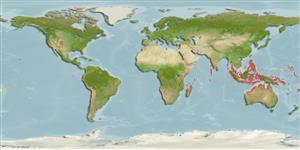>
Ovalentaria/misc (Various families in series Ovalentaria) >
Pomacentridae (Damselfishes) > Pomacentrinae
Etymology: Neopomacentrus: Greek, neos = new + Greek,poma = cover, operculum + Greek,kentron = sting (Ref. 45335).
More on author: Bleeker.
Environment: milieu / climate zone / depth range / distribution range
Ekologi
laut; air tawar; payau dasar (demersal); kisaran kedalaman 0 - 3 m (Ref. 7247). Tropical; 23°C - 28°C (Ref. 12468); 19°N - 21°S
Indo-West Pacific: East Africa to Indonesia and the Solomon Islands, north to the Philippines, south to northern Australia and Vanuatu. Reported from Taiwan (Ref. 5193).
Size / Weight / umur
Maturity: Lm ? range ? - ? cm
Max length : 10.0 cm TL jantan/; (Ref. 48636)
deskripsi pendek
Kunci identifiaksi (pengenalan) | Morfologi | Morfometrik
Duri punggung (Keseluruhan (total)) : 13; duri punggung lunak (Keseluruhan (total)) : 11 - 12; Duri dubur: 2; Sirip dubur lunak: 11 - 12.
Adults inhabit mangroves, estuaries, lower reaches of freshwater streams, and harbors with freshwater discharge. Also found in pure fresh water, but always within a few kilometers of the sea (Ref. 2847). They occur in brackish waters of coastal embayments and mangrove estuaries (Ref. 44894). Spawning may take place in both brackish and fresh waters (Ref. 2847). Oviparous, distinct pairing during breeding (Ref. 205). Eggs are demersal and adhere to the substrate (Ref. 205). Males guard and aerate the eggs (Ref. 205). Diurnal species (Ref. 52881).
Life cycle and mating behavior
Kematangan | Reproduksi, perkembang biakan | Pemijahan | telur-telur | Fecundity | Larva
Oviparous, distinct pairing during breeding (Ref. 205). Eggs are demersal and adhere to the substrate (Ref. 205). Males guard and aerate the eggs (Ref. 205).
Allen, G.R., 1991. Damselfishes of the world. Mergus Publishers, Melle, Germany. 271 p. (Ref. 7247)
Status IUCN Red List (Ref. 130435: Version 2024-2)
ancaman kepada manusia
Harmless
penggunaan manusia
Perikanan: nilai komersial kecil
Alat, peralatan
laporan khas
muat turun XML
Sumber internet
Estimates based on models
Preferred temperature (Ref.
123201): 26.8 - 29.3, mean 28.7 °C (based on 2180 cells).
Phylogenetic diversity index (Ref.
82804): PD
50 = 0.5000 [Uniqueness, from 0.5 = low to 2.0 = high].
Bayesian length-weight: a=0.01479 (0.00651 - 0.03363), b=3.00 (2.81 - 3.19), in cm total length, based on LWR estimates for this (Sub)family-body shape (Ref.
93245).
Trophic level (Ref.
69278): 3.4 ±0.45 se; based on food items.
Daya lenting (Ref.
120179): Tinggi, Waktu penggandaan populasi minimum kurang dari 15 bulan (Preliminary K or Fecundity.).
Fishing Vulnerability (Ref.
59153): Low vulnerability (10 of 100).
Nutrients (Ref.
124155): Calcium = 364 [206, 917] mg/100g; Iron = 1.72 [1.04, 3.06] mg/100g; Protein = 18.3 [17.3, 19.3] %; Omega3 = 0.225 [0.113, 0.453] g/100g; Selenium = 19.5 [9.3, 44.0] μg/100g; VitaminA = 63.1 [22.5, 175.6] μg/100g; Zinc = 2.16 [1.43, 3.28] mg/100g (wet weight);
